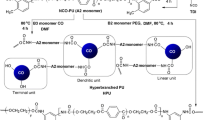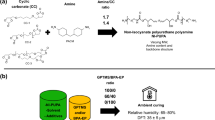Abstract
Polyurethane coatings were prepared by the "prepolymer mixing" method in two steps, i.e. synthesis of prepolymer and further the reaction of the obtained prepolymer with branched polyester. The synthesis of the urethane prepolymer in the reaction of aliphatic diisocyanates [2.4.4-trimethyl-1.6-hexamethylene diisocyanate (TMDI) and 3-isocyanato-3.5.5-trimethylcyclohexyl isocyanate (IPDI) and trimethylolpropane (TMP)] in xylene were carried out in presence of stannous 2-ethyl hexanoate. Next, the obtained prepolymer was exposed to the reaction with branched polyester polyols. This reaction was carried out in presence of the catalysts: DABCO, TEA and stannous 2-ethyl hexanoate. In the synthesis of polyurethanes the aliphatic diisocyanates with linear (TMDI) and cyclic (IPDI) structures were used. The polyurethanes obtained using these diisocyanates hadn't oxidized. Oxidation is disadvantageous particularly in case of the coating, containing aromatic diisocyanates. The changes in the quality are monitored by determining some properties of the cured coating, such as hardness, flexibility and scratch resistance.
Zusammenfassung
Polyurethan-Anstriche wurden mittels der Prepolymer-Misch-Methode in zwei Schritten vorbereitet und zwar die Synthese des Prepolymer und die weitere Reaktion des Prepolymers mit verzweigtem Polyester. Die Synthese des Urethan-Prepolymers aus aliphatischen Diisocyanaten wurde in Gegenwart von Zinn-2-ethylhexonat durchgeführt. Als nächstes wurde das erhaltene Prepolymer mit verzweigtem Polyester gekoppelt. Diese Reaktion wurde mittels der Katalysatoren: DABCO, TEA und Zinn-2-ethylhexonat durchgeführt. Bei der Synthese von Polyurethan wurden aliphatischen Dissocyanate mit linearen (TMDI) und zyklischen (IPDI) Strukturen verwendet. Die Polyurethane, die mittels dieser Diisocyanate gewonnen wurden, waren nicht oxidiert. Die Oxidation ist ungünstig, vor allem im Falle eines Anstrichs, der aromatische Diisocyanate enthält. Die Veränderungen in der Qualität wurden beobachtet durch Messen einiger Eigenschaften des Anstrichs, wie Härte, Flexibilität und Kratzfestigkeit.


Similar content being viewed by others
References
Brock T, Groteklaes M, Mischke P (2001) Polyurethane coating systems. European Coatings Journal (1–2):110–111
Jaic M, Zivanovic R (1997) The influence of the ratio of the polyurethane coating components on the quality of finished wood surface. Holz als Roh- und Werkstoff 55(5):319–322
Lai YC, Quinn ET (1995a) Syntheses and characterization of UV-curable polisiloxane based polyurethane prepolymers. J Polym Sci Part A 33:1783–1793
Lai YC, Quinn ET, Valint PL (1995b) Control of hard segment size in polyurethane formation. J Polym Sci Part A 33:1767–1772
Wejchan-Judek M, Polus I, Doczekalska B, Pertek H (2001) Trimerization of 3-isocyanatomethyl-3.5.5-trimethylcyclohexyl isocyanate (IPDI). Polimery 46(2):131–132
Author information
Authors and Affiliations
Corresponding author
Rights and permissions
About this article
Cite this article
Polus, I. Synthesis of polyurethane coating components with IPDI and TMDI. Holz Roh Werkst 61, 238–240 (2003). https://doi.org/10.1007/s00107-003-0390-9
Published:
Issue Date:
DOI: https://doi.org/10.1007/s00107-003-0390-9




